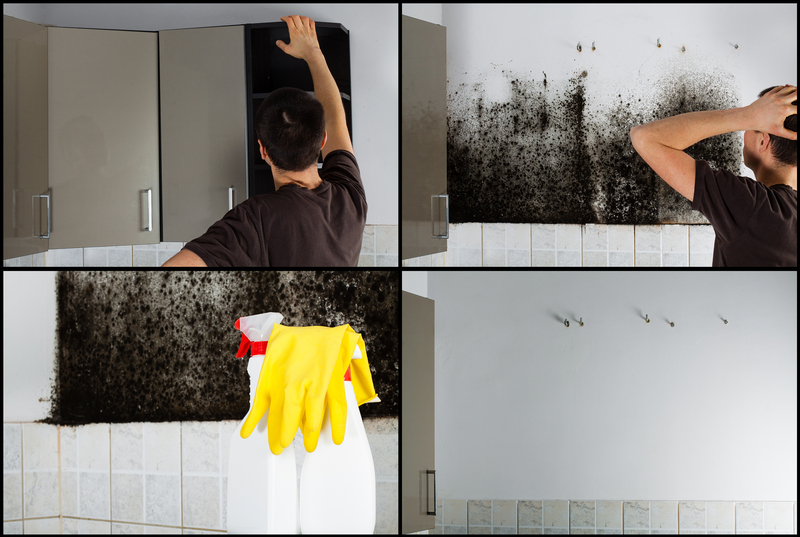Wave Goodbye to Mould on Window Sills with Our Guide
Posted on 03/09/2025
Wave Goodbye to Mould on Window Sills with Our Guide
If you've noticed unsightly black or green patches creeping along your window sills, mould is likely to blame. Not only is it unsightly, but mould on window sills can also compromise your indoor air quality and affect your health. Thankfully, you don't have to live with it! In this comprehensive article, we'll show you how to prevent and remove mould from your window sills, why it forms in the first place, and the best practices to keep your windowsill areas safe and clean for good.
What is Mould and Why Does it Grow on Window Sills?
Mould is a type of fungus that can thrive in moist, humid environments. Window sills are a common target because they frequently accumulate condensation, especially during colder months when warm indoor air meets chilly glass. Mould, particularly black mould (Stachybotrys chartarum), loves to colonize in such damp spots.
Understanding the Causes: Triggers for Mould Growth on Your Windowsills
- Condensation: Window sills are often the first place moisture collects, especially during winter.
- Poor Ventilation: Without enough airflow, humidity lingers, creating ideal conditions for mould.
- Leaking Windows: Faulty seals or cracks can allow rainwater inside, keeping your window sill damp.
- Organic Materials: Any dust, dead insects, or plant debris provide nutrients for mould spores to grow.
Being aware of these triggers is the first step in eliminating and preventing window sill mould completely.

Health Risks Associated with Window Sill Mould
It's not just about appearances: mould exposure can lead to several health problems, especially in individuals sensitive to mould spores. Common symptoms include:
- Respiratory issues (coughing, sneezing, or wheezing)
- Eye, nose, or throat irritation
- Skin rashes
- Asthma flare-ups
- In severe cases, prolonged exposure can cause chronic sinus infections or allergic reactions.
Tackling the root of the mould problem on your window sill is essential for both comfort and health!
Step-By-Step Guide: How to Remove Mould from Window Sills
Ready to wave goodbye to mould on your window sills? Follow this detailed, effective removal process:
1. Gather Your Cleaning Supplies
- Protective gloves and mask: Mould can release spores, so protect yourself.
- Soft brush or an old toothbrush
- White vinegar or hydrogen peroxide (3%): Both are effective, non-toxic options.
- Spray bottle
- Cloths or paper towels
- Warm water and mild detergent
- Garbage bag for disposal
2. Ensure Proper Ventilation
Open windows or turn on a fan to minimize inhaling spores while cleaning.
3. Apply the Cleaning Solution
- Pour vinegar or hydrogen peroxide into a spray bottle (never mix chemicals).
- Spray generously onto the affected area and allow to sit for 10-15 minutes.
4. Scrub the Mould
- Use a soft brush or toothbrush to gently scrub away the mould from the window sill.
- For stubborn patches, repeat spraying and scrubbing.
5. Wipe and Rinse
- Wipe away residue with a damp cloth.
- Dry the area completely to prevent re-growth.
6. Dispose of Contaminated Materials
- Seal used paper towels or wipes in a plastic bag before throwing out.
- Wash cleaning cloths in hot water.
Preventing Mould from Returning to Your Window Sills
Once your window sills are mould-free, the next goal is to ensure the fungus doesn't come back. Check out these proven prevention strategies:
- Improve Air Circulation: Open windows regularly and use exhaust fans in kitchen and bathrooms.
- Control Humidity: Keep indoor levels between 30-50% with a dehumidifier if necessary.
- Use Window Insulation Kits: Prevent condensation with insulating film during the colder months.
- Fix Leaks Promptly: Check window seals and repair any cracks or weather stripping.
- Schedule Regular Cleaning: Dust and wipe window sills frequently to avoid build-up of organic material.
Additional Tips for Long-Lasting Results
- Consider anti-mould paint or sealant for wood or plaster sills.
- Move furniture away from windows to ensure better airflow.
- Keep house plants away from sills that are prone to mould, as moist soil and watering can add to humidity.
Choosing Mould-Proof Materials for New Window Sills
If you're renovating or replacing your window sills, opt for materials less likely to support fungal growth. Here are some mould-resistant window sill options:
- UPVC (unplasticised polyvinyl chloride): Popular for its water resistance and smooth, wipe-clean surface.
- Stone or engineered stone: Much less absorbent than wood, reducing moisture retention.
- Sealed hardwood: If you must have wood, ensure it's well-sealed and varnished to protect against water ingress.
Regardless of material, keeping the area dry and clean is crucial.
Frequently Asked Questions about Mould on Window Sills
Is mould on window sills dangerous?
Mould on window sills can be dangerous, especially for those with allergies, asthma, or weakened immune systems. Prompt removal and prevention are important for overall health and well-being.
Why does mould keep coming back on my window sills?
Recurring mould generally signals ongoing moisture issues--such as condensation, poor ventilation, or undetected leaks. Addressing the root cause is key to stopping mould for good.
Can I paint over mould on window sills?
Never paint over existing mould! Always remove it thoroughly and allow the surface to dry. Only then should you consider repainting, preferably with an anti-mould formula.
Will bleach kill mould on my window sill?
Bleach can kill surface mould and lighten stains, but it often doesn't reach mould roots embedded in porous materials. Vinegar or hydrogen peroxide are better for deeper cleaning and safer for your lungs.
Eco-Friendly Ways to Tackle Mould on Window Sills
If you prefer natural solutions for treating mould on window sills, try these gentle yet effective remedies:
- White vinegar: Spray, let sit, then scrub as described above.
- Baking soda: Mix with water for a scrubbing paste; it also helps deodorize.
- Tea tree oil: A few drops in water creates a potent mould killer, though it's pricier than other options.
*Always test a small, inconspicuous area before applying any treatment to your window sills.*
When to Call a Professional for Mould Remediation
If the mould patch on your window sill is larger than about one square metre, or you notice recurring, heavy infestations in several rooms, it's best to consult an expert. Professional mould remediation teams have the tools, treatments, and experience to tackle extensive growth and prevent future flare-ups.

Summary: Say Goodbye to Window Sill Mould for Good
- Identify and eliminate moisture sources to stop mould before it starts.
- Clean up existing mould quickly and safely, using gloves and a respirator if necessary.
- Keep window sills dry, clean, and well-ventilated to prevent recurrence.
- Choose mould-resistant materials when upgrading window sills.
Wave goodbye to mould on window sills once and for all by following these actionable steps and prevention tips. Your home will be healthier, fresher, and your windows will once again be a clear view to the world--without the worry of lurking mould!
Further Reading and Resources
For more home maintenance tips and eco-friendly living advice, explore our website and empower yourself to keep every corner of your home safe, healthy, and beautiful!




